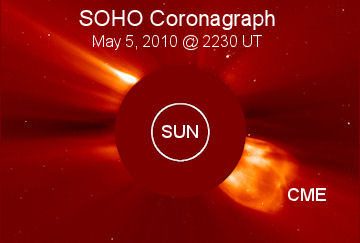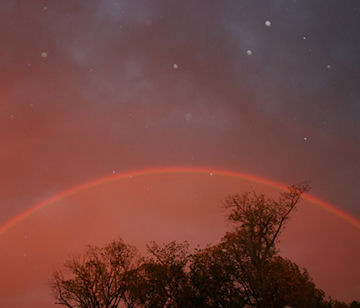NEW AND IMPROVED: Turn your iPhone or iPod Touch into a field-tested global satellite tracker. The Satellite Flybys app now works in all countries. | | | METEORS FROM HALLEY'S COMET: The eta Aquarid meteor shower, caused by dust from Halley's Comet, peaks this year on May 6th and 7th. The shower is strongest over the southern hemisphere, where observers could see more than 30 meteors per hour despite the bright light of a waning half Moon. No matter where you live, the best time to look is during the hours before local sunrise on Friday. [full story] meteor photos: from John Chumack of Dayton, Ohio; from Thomas Ashcraft near Santa Fe, New Mexico CINCO DE MAYO BLAST: With May 5th winding down, magnetic fields on the sun wound up and erupted, producing a bright coronal mass ejection (CME). Click on the image to set the cloud in motion: 
The eruption came from a spotless region near the sun's southwestern limb. Extreme ultraviolet images from SOHO pinpoint the blast site: movie. The billion-ton cloud is not heading directly for Earth, although it could deliver a glancing blow to our planet's magnetic field on or about May 8th. High-latitude sky watchers should be alert for auroras this weekend. May 2010 Aurora Gallery
[previous Mays: 2008, 2005, 2004, 2003, 2002] [aurora alerts] RED RAINBOW: Yesterday in Muncie, Indiana, the sun was just about to set when--"Wow! This red rainbow popped up out of nowhere," reports Mike Hutchinson. "It hung there for about 15 minutes--just enough time to grab my camera and snap a rain-splattered picture." 
What made the rainbow red? Simple. The sun itself was red. "The sun was low in the west and strongly reddened by atmospheric scattering and ominous-looking clouds," says Hutchinson. The real question. according to Hutchinson, is why the inside of the rainbow was so much brighter red than the outside. Atmospheric optics expert Les Cowley has the answer: "A rainbow is not just a set of colored rings, but rather a set of colored disks. The sky inside is bright because raindrops direct light there, too." All rainbows have this property, but it is particularly evident when the sky above the 'bow is dark and cloudy--as it was on May 3rd in Muncie, Indiana. Got sunset, clouds and rain? Be alert for red rainbows! more images: from Lauri Kangas of Caledon, Ontario, Canada | 
